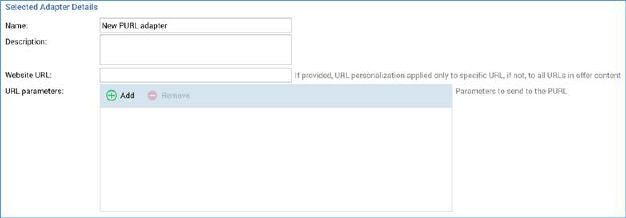
When a PURL adapter is selected in the web adapters list, the Selected Adapter Details section contains the following updateable fields:

•Name: a mandatory text field that can be a maximum of 100 characters in length. Set by default to 'New PURL Adapter' (an integer can be appended to ensure uniqueness).
•Description: an optional text field that can be a maximum of 1000 characters in length.
•Web site URL: an optional text field that can be a maximum of 1000 characters in length. If a web site URL is provided, the parameters appended to any URLs within a message’s content are applied only to instances of the specified URL. The value provided must be a valid URL.
•URL parameters: this list allows you to define the adapter’s parameters. Note that it is mandatory to provide at least one URL parameter.
A toolbar is shown at the top of the list, exposing the following options:
o Add: invocation adds a new URL parameter to the grid. Its attribute is not set, and its default name is set to ‘NewParameter’ (an integer can be appended to ensure uniqueness).
o Remove: invocation removes the selected parameter, without displaying an ‘Are You Sure?’ dialog.
The list itself displays two columns:
o Attribute: provision of an attribute to map to the parameter is mandatory. You can provide an attribute using drag and drop, or you can browse for one using the recent items chooser or File System Dialog. Parameter attributes are supported.
Once an attribute has seen selected for the parameter, you can invoke View Information (to view its details in the File Information dialog). You can also Clear the selected attribute.
o Parameter name: provision of a name for the parameter is mandatory, and the value can be up to 100 characters long. The name provided must be unique within the adapter.
o Default Value: this optional property supports a maximum of 100 characters. It can be used to provide a default value, to be substituted in the event of a null attribute value.
When you hover over a URL parameter a Remove button is displayed to the right; invocation thereof removes the parameter without displaying an ‘Are You Sure?’ dialog.